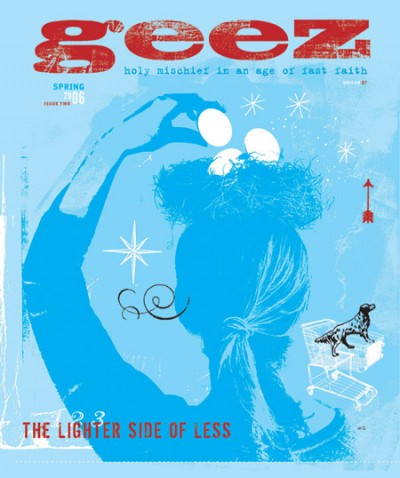Less: The new future is circular
It seems presumptuous to contemplate re-arranging the plot and metaphors of human history, but why not experiment with the intersection of imagination and the actual choices of living toward an age of less. As someone more into farming and cycling than metaphors and narrative, I am reluctant to wander this far from the realm of dirt and muscle, but perhaps a brief foray is in order.
The imagery of progress moves us up and away from the circle of the earth: we climb the corporate ladder, we climb Jacob’s ladder, we construct towers of Babel, we reach for the stars. Corporate board rooms are on top floors of office towers. But we can no longer keep heading onward and upward, leaving the earth and the majority of humanity behind.
We’re being drawn back down by the gravitational pull of the earth. Natural forces are reigning us in, inviting us back. The ascetic discipline of our time is that of living in unity with the earth and others; of feeling the pull of this gravity that brings us down to earth.
Many ascetic mystics spoke of unity – perhaps not in relation to climate change or global disparity, but nonetheless they sought to be united with all. Evagrius Ponticus wrote, “A monk is one who is both separated from all and yet united with all.” Similarly, Thomas Merton said, “When I am alone they are not ‘they’ but my own self.”
John O’Donohue, the contemporary Irish poet, speaks of unity as a grand circularity. “The creator of the universe loves circles: time and space are circles, the day is a circle, the year is a circle, the earth is a circle.” O’Donohue writes beautifully about the inclusiveness and unity of a “great circle of belonging” which encompasses humanity, the earth and God.
Whereas progress is a straight line, the new future may be more circular and spherical. Both O’Donohue’s flowing imagery and tender tone contrast with the growth charts, bottoms lines an competitive self-interest of the marketplace. He calls us to abandon the path of perpetual growth and re-enter the circles that encompass all, and the cycles that balance time.
Frankly, this mystic unity means little to me without the practical, everyday incarnation of it. I know the belonging of the circle when I bike, grow food, forgo extras, conserve energy, do it myself and buy used. And I know exclusion when I don’t. For me the words of the mystics and the poetry of O’Donohue nurture an inner shift that makes living within the parameters of earth truly desirable.
Renegade ascetic Henry David Thoreau was someone who possessed not only the practical skills of simplicity, but also the ability to re-orient his mind and spirit so that the notion of less became more attractive than progress. “My greatest skill,” he wrote, “has been to want but little.” He embraced as virtue that which progress saw as ludicrous. “[One] is rich,” he said, “in proportion to the number of things which [one] can afford to let alone.”
Will Braun is editor of Geez magazine



Sorry, comments are closed.